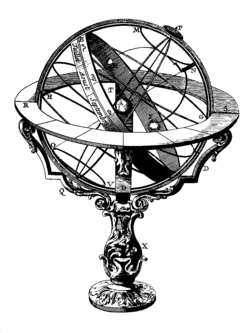Armillary sphere
|
|
An armillary sphere (also known as spherical astrolabe) is a model of the celestial sphere, invented by Eratosthenes in 255 BC. Its name comes from the Latin armilla (circle, bracelet), since it has a skeleton made of graduated metal circles linking the poles and representing the equator, the ecliptic, meridians and parallels. Usually a ball representing the Earth or, later, the Sun is placed in its center. It is used to demonstrate the motion of the stars around the Earth.
Armillary spheres were developed by the Greeks and were used as teaching tools already in the 3rd century B.C.. In larger and more precise forms they were also used as observational instruments, being preferred by Ptolemy. Armillary spheres became popular again in the late middle ages; the Danish astronomer Tycho Brahe (1546-1601) constructed several of such instruments.
Renaissance scientists and public figures often had their portraits painted showing them with one hand on an armillary sphere, which represented the height of wisdom and knowledge.
ArmillarySphere1.JPG
Armillary spheres were among the first complex mechanical devices. Their development led to many improvements in techniques and design of all mechanical devices.
A representation of an armillary sphere is present in the modern flag of Portugal and has been a national symbol since the reign of Manuel I.
See also
- Antikythera mechanism
- Astrolabe
- Astronomical clock
- Orrery, a free-standing solar system model
- Planetarium
- Prague Orloj
- Torquetum
External links
- Starry Messenger (http://www.hps.cam.ac.uk/starry/armillary.html)
- Instructions for constructing an armillary sphere (http://www.humboldt.edu/~rap1/EarlySciInstSite/Instruments/ArmSphere/ArmilSph.htm)
de:Armillarsphäre fr:Sphère armillaire it:Sfera armillare nl:armillarium zh:渾天儀

